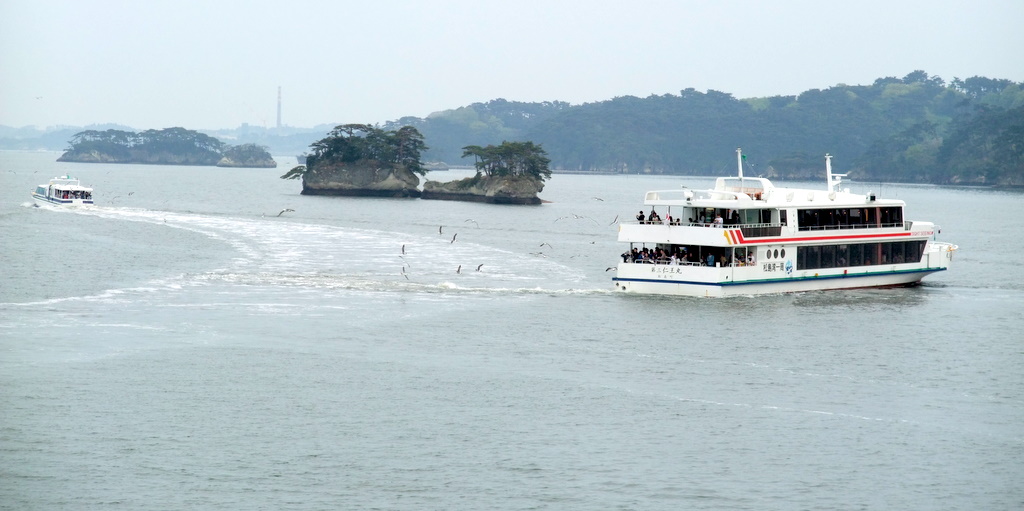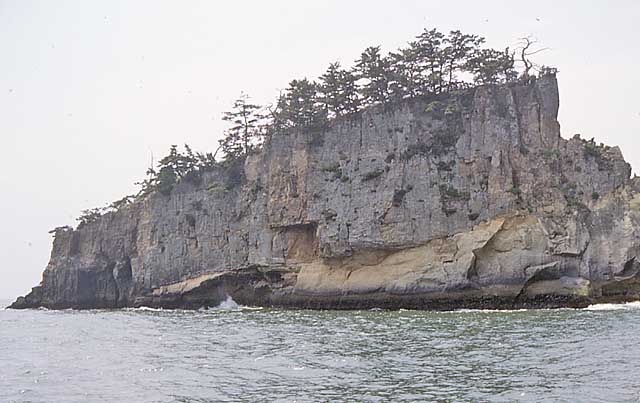Matsushima S on:
[Wikipedia]
[Google]
[Amazon]





 is a group of islands in
is a group of islands in
Image:matsushima otakamori08Dec07.jpg, Magnificent View: The view from Otakamori
Image:matsushima tomiyama10Mar07.jpg, Beautiful View: The view from Tomiyama
Image:matsushima ogidani23Nov07.jpg, Enchanting View: The view from Ogitani
Image:matsushima tamonsan11Feb07.jpg, Grand View: The view from Tamonzan
Image:Nioujima.jpg, Niōjima
Image:Senganjima.jpg, Senganjima:
Matsushima Town Tourism Directory
{{Coord, 38, 22, N, 141, 05, E, type:isle_region:JP, display=title Tourist attractions in Miyagi Prefecture Special Places of Scenic Beauty Archipelagoes of Japan Japanese archipelago Islands of Miyagi Prefecture Archipelagoes of the Pacific Ocean





 is a group of islands in
is a group of islands in Miyagi Prefecture
is a Prefectures of Japan, prefecture of Japan located in the Tōhoku region of Honshu. Miyagi Prefecture has a population of 2,265,724 (1 August 2023) and has a geographic area of . Miyagi Prefecture borders Iwate Prefecture to the north, Akit ...
, Japan
Japan is an island country in East Asia. Located in the Pacific Ocean off the northeast coast of the Asia, Asian mainland, it is bordered on the west by the Sea of Japan and extends from the Sea of Okhotsk in the north to the East China Sea ...
. There are some 260 tiny islands (''shima'') covered in pines (''matsu'') – hence the name – and it is considered to be one of the Three Views of Japan
The is the canonical list of Japan's three most celebrated scenic sights, attributed to a 1643 book by the scholar Hayashi Gahō.
In 1915, modeled on the old Three Views of Japan, Jitsugyo no Nihon Sha (株式会社実業之日本社) held a n ...
.
Nearby cultural properties include Zuigan-ji
is a Rinzai Zen Buddhism, Buddhist temple in located in the town of Matsushima, Miyagi, Matsushima, Miyagi Prefecture, Japan. Belonging to the Myōshin-ji branch of Rinzai Zen, it was founded in 828 during the Heian period by Ennin, Jikaku Da ...
, Entsū-in, Kanrantei
is the only building to survive from a mansion complex of the Date clan in Matsushima, Miyagi Prefecture, Japan. It is said to have originated as a teahouse in Toyotomi Hideyoshi's Fushimi Castle, to have been moved to Edo by Date Masamune, and f ...
, and the Satohama shell mound.
Views
A well-knownhaiku
is a type of short form poetry that originated in Japan. Traditional Japanese haiku consist of three phrases composed of 17 Mora (linguistics), morae (called ''On (Japanese prosody), on'' in Japanese) in a 5, 7, 5 pattern; that include a ''kire ...
describes the islands as so striking that the poet is at a loss for words:
While often attributed to Matsuo Bashō
; born , later known as was the most famous Japanese poet of the Edo period. During his lifetime, Bashō was recognized for his works in the collaborative '' haikai no renga'' form; today, after centuries of commentary, he is recognized as th ...
, the earliest known publication is in the ''Matsushima Zushi'' (松島図誌), published in 1820 over a century after Bashō's death, which attributes it to the ''kyōka
''Kyōka'' (, "wild" or "mad poetry") is a popular, parodic subgenre of the tanka form of Japanese poetry with a metre of 5-7-5-7-7. The form flourished during the Edo period (17th–18th centuries) and reached its zenith during the Tenmei era ...
'' poet Tawara-bō (田原坊). While Bashō did visit Matsushima in ''Oku no Hosomichi
, translated as ''The Narrow Road to the Deep North'' and ''The Narrow Road to the Interior'', is a major work of ''haibun'' by the List of Japanese language poets, Japanese poet Matsuo Bashō, considered one of the major texts of Japanese liter ...
'', its only haiku about Matsushima was written by his travel comparison Kawai Sora
, translated as ''The Narrow Road to the Deep North'' and ''The Narrow Road to the Interior'', is a major work of ''haibun'' by the Japanese poet Matsuo Bashō, considered one of the major texts of Japanese literature of the Edo period.
The firs ...
.
Four views of Matsushima
There are four well-known spots to view the Matsushima, known as the , , , and .Cruise
Tourists can view the islands from up close on cruise boats.Masamune Date
was a Japanese ''daimyō'' during the Azuchi–Momoyama period through the early Edo period. Heir to a long line of powerful feudal lords in the Tōhoku region, he went on to found the modern-day city of Sendai. An outstanding tactician, he w ...
's favorite island
Image:Komonejima.jpg, Komonejima
Image:Matsushima famous island.jpg, Kanejima
Image:Futagojima.jpg, Futagojima
Image:Misagojima.jpg, Misagojima
Image:Kaerujima.jpg, Kaerujima
Image:Meganejima.jpg, Takashima, also known as Meganejima
Transportation
The town is only a short distance (thirty minutes, about 14 km) from prefectural capitalSendai
is the capital Cities of Japan, city of Miyagi Prefecture and the largest city in the Tōhoku region. , the city had a population of 1,098,335 in 539,698 households, making it the List of cities in Japan, twelfth most populated city in Japan.
...
and is easily accessible by train
A train (from Old French , from Latin">-4; we might wonder whether there's a point at which it's appropriate to talk of the beginnings of French, that is, when it wa ... , from Latin , "to pull, to draw") is a series of connected vehicles th ...
. Matsushima-Kaigan Station
is a railway station in the town of Matsushima, Miyagi Prefecture, Japan, operated by East Japan Railway Company (JR East).
Lines
Matsushima-Kaigan Station is served by the Senseki Line. It is located 23.2 rail kilometers from the terminus of t ...
is near the attractions such as Zuiganji and the waterfront. Matsushima Station
is a railway station in the town of Matsushima, Miyagi, Japan, operated by East Japan Railway Company (JR East). This station is about 1 km from Takagimachi Station and about 2 km away from Matsushima-Kaigan Station on the Senseki L ...
, on a separate line is on the opposite side of the town.
2011 Tōhoku earthquake
Despite the proximity of Matsushima to the2011 Tōhoku earthquake and tsunami
On 11 March 2011, at 14:46:24 Japan Standard Time, JST (05:46:24 UTC), a 9.0–9.1 Submarine earthquake, undersea megathrust earthquake occurred in the Pacific Ocean, east of the Oshika Peninsula of the Tōhoku region. It lasted approx ...
, the area was protected by the islands and suffered relatively little damage. The initial tsunami was 3.2 metres (10.5 feet) with the second 3.8 metres (12.5 feet). Electricity was restored by March 18, water fully restored by April 16 and the Senseki Train Line between Takagimachi Station and Sendai by May 28. Nevertheless, three people were confirmed killed in Matsushima (including by aftershocks) with 18 killed while out of town.
Activities
Around the island travelers can go on a cruise and view the islands up close, and around the Matsushima shore travelers can rent bikes.See also
*List of Special Places of Scenic Beauty, Special Historic Sites and Special Natural Monuments
To protect Japan's cultural heritage, the country's government selects through the Agency for Cultural Affairs important items and designates them as Cultural Properties of Japan, Cultural Properties under the Law for the Protection of Cultural Pro ...
References
External links
Matsushima Town Tourism Directory
{{Coord, 38, 22, N, 141, 05, E, type:isle_region:JP, display=title Tourist attractions in Miyagi Prefecture Special Places of Scenic Beauty Archipelagoes of Japan Japanese archipelago Islands of Miyagi Prefecture Archipelagoes of the Pacific Ocean